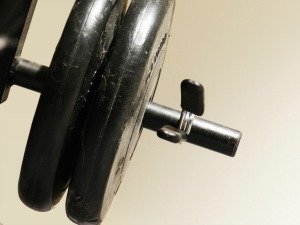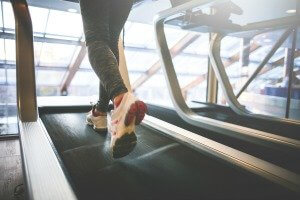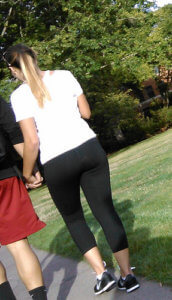It’s Really Hard to Lose Weight, and Now You’ve Just Depressed Me
I get it. It is really hard to lose weight, and I would have depressed myself, too – except I know it can be done. I am shaping up, myself, and I’m seeing results. My kids got me to start going to the gym a few years ago. Then I stopped doing weights and started running, but although I enjoyed it, I got plantar fasciitis and was hobbling around every morning when I got out of bed.
Then my daughter sent me a link to this great website called Bodybuilding.com. After doing just weights, and then switching to just cardio, I have finally figured out that it’s better to do both. (I also want to state publicly that my daughter tried to tell me this, years ago, but I didn’t get it. I do now.)
None of this is as hard as you might think. Here’s the routine I have been doing: http://www.bodybuilding.com/fun/randy29.htm
I don’t even do all of it! It starts with crunches. I don’t do them. I go to my local YMCA, and frankly, the floor is gross. They have mats you can use, but they’re gross, too. I don’t want to be on them. This is not your fancy clientele, as evidenced by the sign over the water fountain telling people not to spit in it. Sometimes people don’t read the sign, that’s all I’m going to say.
There are 12 exercises, and before you think, “oh, Lord, how long will that take,” let me reassure you that each one just takes a few minutes. And again – I don’t do them all! It’s not that bad.
 I start with the “barbell bench press.” I do 40 pounds. Don’t laugh; it used to be 30. That’s okay. If 40 gets easy, I will move up to 50. Baby steps, people. Then I do the dumbbell shoulder press. I do 12 pounds each; again, you could laugh at the girly lack of weight, but it used to be 10 pounds. One-arm dumbbell row, 25 pounds; it used to be 15. Wide-grip lat pulldown: I do 50 pounds. It used to be 40. Seated cable rows: I do 40 pounds. That hasn’t changed, but I was doing it wrong at first, and now that I’m doing it right, that’s a good weight for me. Barbell curl: I don’t do it, but I do the dumbbell curls instead; 15 pounds, used to be 10. Triceps pushdown: I do 45 pounds. I used to do 40. Barbell full squat: The pole that holds the barbells weighs 45 pounds; I add 50 to that. Leg extensions: I do 50 pounds; used to do 30 when I started. Lying leg curls: I do 50 pounds. I don’t like them, so I often don’t do them. And that’s okay, because I’m doing the other stuff.
I start with the “barbell bench press.” I do 40 pounds. Don’t laugh; it used to be 30. That’s okay. If 40 gets easy, I will move up to 50. Baby steps, people. Then I do the dumbbell shoulder press. I do 12 pounds each; again, you could laugh at the girly lack of weight, but it used to be 10 pounds. One-arm dumbbell row, 25 pounds; it used to be 15. Wide-grip lat pulldown: I do 50 pounds. It used to be 40. Seated cable rows: I do 40 pounds. That hasn’t changed, but I was doing it wrong at first, and now that I’m doing it right, that’s a good weight for me. Barbell curl: I don’t do it, but I do the dumbbell curls instead; 15 pounds, used to be 10. Triceps pushdown: I do 45 pounds. I used to do 40. Barbell full squat: The pole that holds the barbells weighs 45 pounds; I add 50 to that. Leg extensions: I do 50 pounds; used to do 30 when I started. Lying leg curls: I do 50 pounds. I don’t like them, so I often don’t do them. And that’s okay, because I’m doing the other stuff.
 Then I do 20 minutes on the treadmill; I used to run, now I walk briskly. I also have a Chocolate Lab who is insane, and I take her for long walks, too. Combining both the weights and the walking really has made a huge difference for me.
Then I do 20 minutes on the treadmill; I used to run, now I walk briskly. I also have a Chocolate Lab who is insane, and I take her for long walks, too. Combining both the weights and the walking really has made a huge difference for me.
I have also changed what I eat. This has been difficult, because God help me, I love comfort food. I grew up in the South, and when I go to South Carolina to visit my family, I gravitate to fried chicken, fried okra, fried catfish… notice a theme here? Fried foods are very bad, as we talked about in a previous post. Also, sweet tea is the house wine in the South. I am drinking it straight, without the cup of sugar in each gallon. My relatives are still speaking to me.
More concerning for me, is where my body likes to store fat. I don’t have junk in the trunk, or thunder thighs. Instead, my body wants to put on fat right in the tummy, where it causes the heart to work hardest. It’s not much, but it’s more than I want.
I’m eating food that is better for me, and in return, I actually feel better for it.
You may find a diet that is perfect for you, and if that’s the case, more power to you. I have found that slow and steady wins the race.
Here’s my best tip: Every single little thing you do makes a tiny difference. Have mustard instead of mayo. If you get a sandwich, skip the cheese. Get it on whole-grain bread.
Don’t get chips with it. If you say, “No way, I’m getting chips,” of course that is your right, and it’s your life. How about maybe you get the small size instead of the “sharing size?” At least there are fewer chips in there. You’ve got to start somewhere.
Chicken has fewer calories than beef.
Drink only water or something with no calories, like unsweetened tea. Avoid soda like the plague. Alcohol has a lot of calories. You could start to lose weight right away if you just cut back on that. Watch out for juice; it has a lot more calories than you think. Eat a piece of fruit instead. If you go to Starbucks, get a Refresher, which only has about 35 calories, instead of a Frappucino. Don’t rely on diet drinks; that’s a whole ‘nother blog post, but they still make your body crave sweet things, and this does bad things to your insulin receptors.
Make the effort to limit processed food. Yes, when you’re tired and you just want to eat something fast, it’s a pain to cook from scratch. I know this. I have never been one to make a bunch of meals ahead of time, so I can’t recommend that approach, although a lot of people do it. But it’s not that hard to get a piece of chicken and cook it. You can buy frozen brown rice and microwave it; it takes three minutes. Or cut up that chicken and stick it on top of a store-bought salad mix, then add a simple vinaigrette dressing.
Fast food is bad. Now, you may say, “But I have no choice, I’m on the road, I can’t carry food all the time.” Keeping in mind that you actually could carry granola bars and fruit, I’ll say, “Okay, then watch your calories.” McDonald’s posts the calories right on the sign. If you just have to have a burger, limit your portion size, as the doctors say. Get one of their original small hamburgers, not a cheeseburger. Get a small fry instead of a large. For God’s sake, don’t get a soda. Your insulin receptors will thank you. It’s not great, and I wish you would do something else, but at least you will save hundreds of calories right there. (I will note here that some nutritionists would say I’m being a traitor to the cause: “Eek! Fast food burgers and fries are evil! Shun them! Get a salad instead.” But a lot of people feel that when their doctor gives them a diet, it’s “my way or the highway,” and if they leave the highway once, they might as well just stay off-road. I am hoping you will stay on the road for the long haul.)
Speaking of salads: Salads are good, but if you load them up with a creamy ranch dressing, lots of cheese and croutons, maybe some ham or bacon for good measure, with a big side of bread and butter, you are defeating your purpose.
Take the stairs.
Don’t drive circles around the parking lot looking for that lazy spot right in front of the store. Park farther away from the store and walk.
When you start to exercise, don’t start with heavy weights. Work up to it. Don’t get on the treadmill, run fast and then poop out after two minutes. Start by walking slowly. In my opinion, it’s better to walk slowly for 20 minutes than speed-walk for five. If you don’t have access to a treadmill, set a timer and walk for 20 minutes, at any speed you choose. Anything you do is more than you would accomplish by just sitting still. Trying means a lot.
Don’t get discouraged. The worst thing you can do is try something, decide it’s too hard, then quit because you just know it’s never going to happen, and that you’re a loser, or whatever you might say to yourself. You’re not a loser because you’re trying. No judgment, only encouragement. You are making the effort.
Baby steps.
This lifestyle we have – I’m including myself here, because I’m fighting it, too – has got to change.
We can do this.
©Janet Farrar Worthington

 The good news is that it is never too late to change your lifestyle – and to have this change instantly lower your cancer risk.
The good news is that it is never too late to change your lifestyle – and to have this change instantly lower your cancer risk. The good news is, the risks go down as you shape up.
The good news is, the risks go down as you shape up.